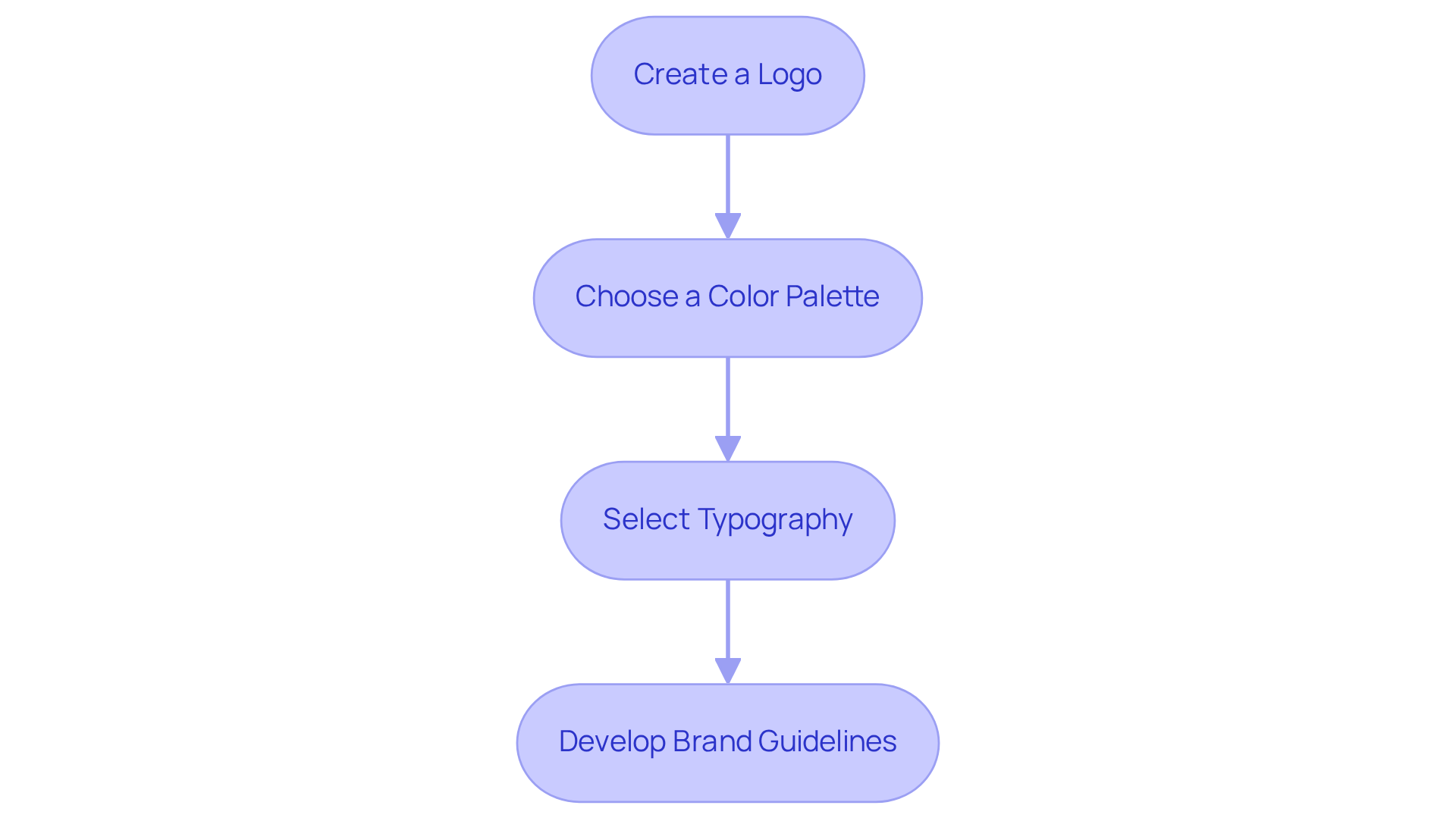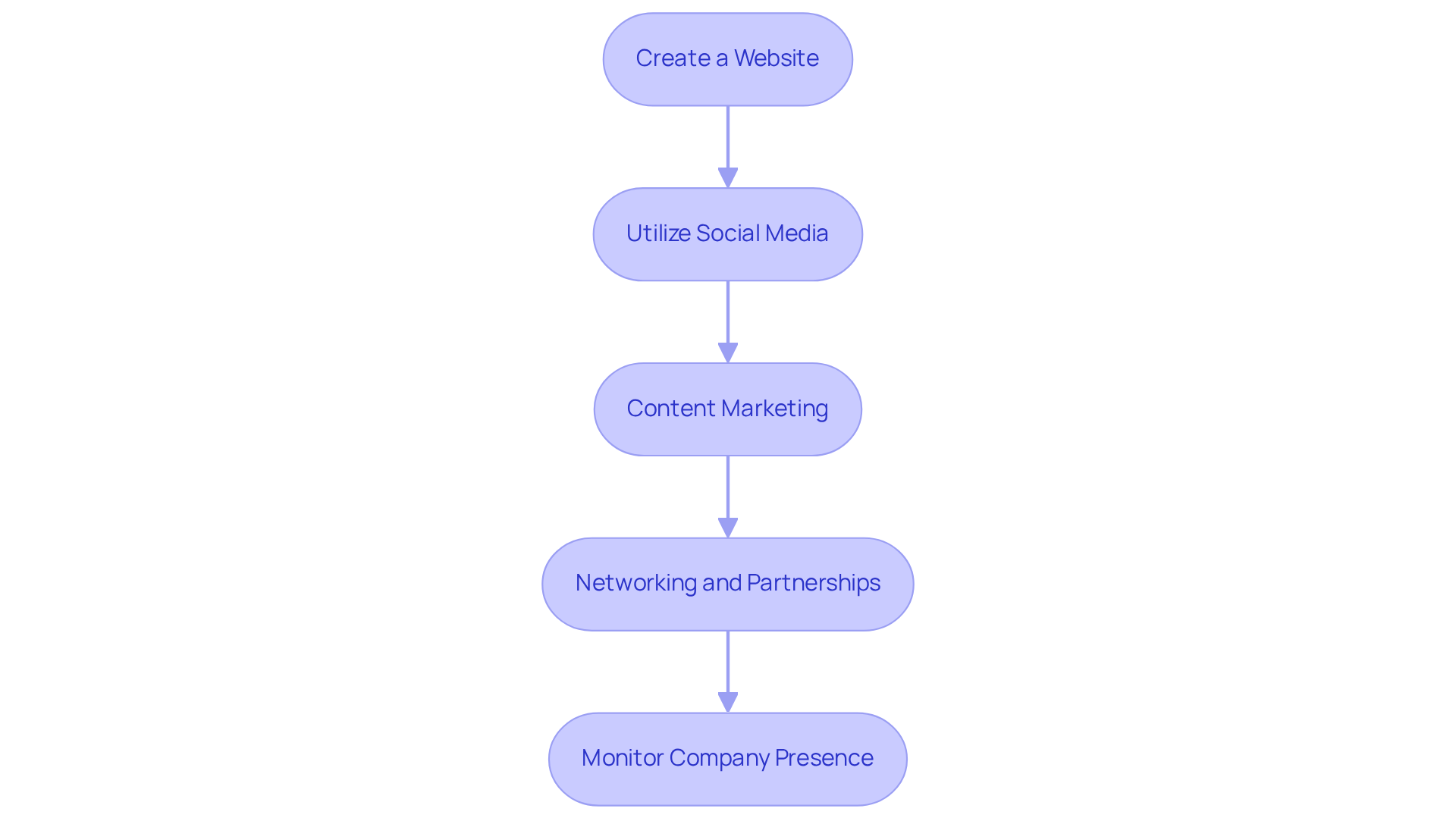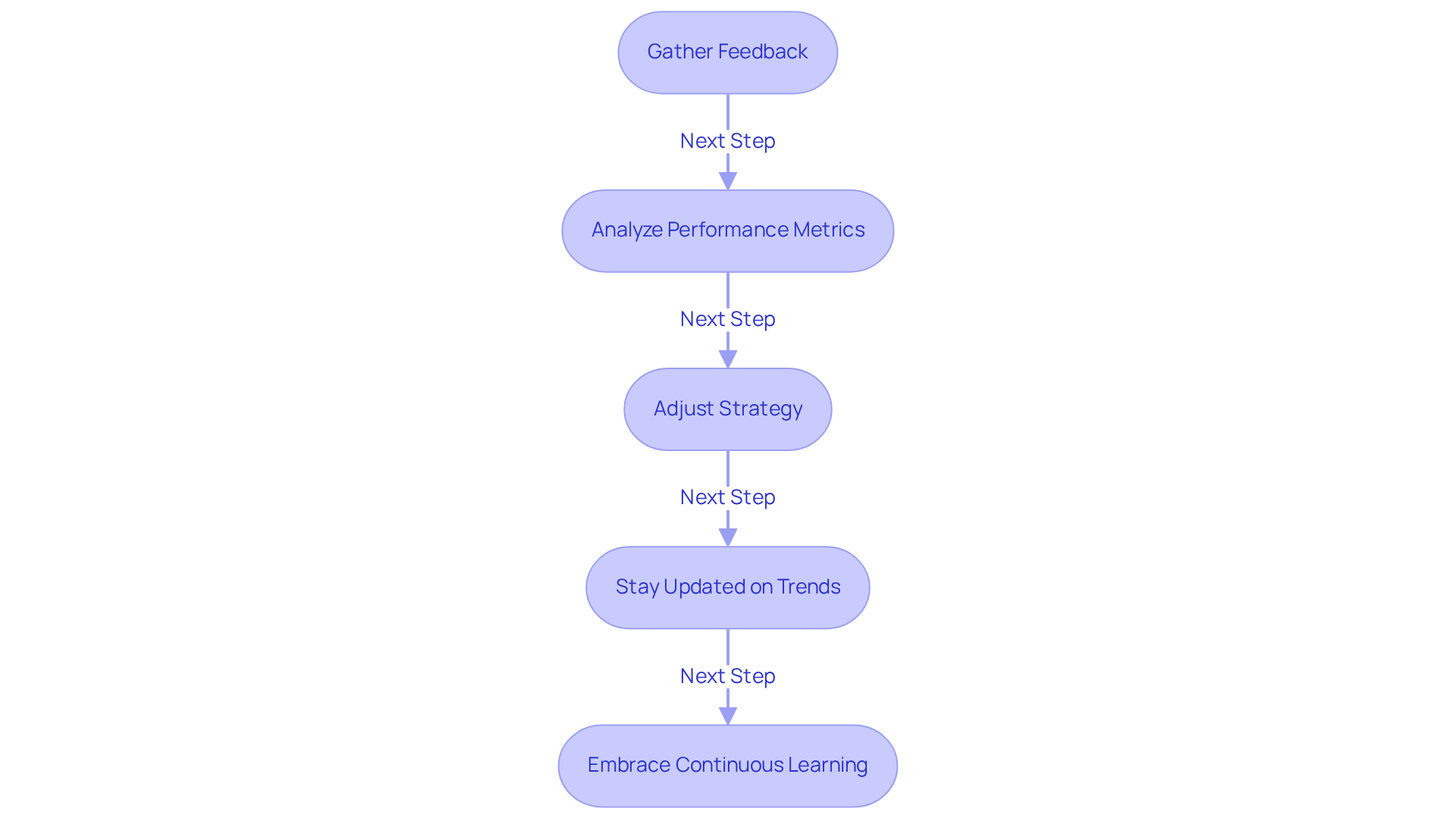Overview
The article highlights a common challenge faced by startups: the struggle to create an effective branding strategy. This can often lead to confusion and inconsistency, making it difficult for new businesses to connect with their audience. It's crucial to address these pain points, as a strong brand identity not only fosters recognition but also builds trust with consumers.
To tackle this issue, the article outlines four essential steps that can guide startups in developing their branding strategy:
- It emphasizes the importance of defining brand identity, which serves as the foundation for all branding efforts.
- Next, it discusses the establishment of key branding elements, ensuring that every aspect of the brand aligns with its core values.
- The implementation of a branding strategy follows, providing a roadmap for bringing the brand to life.
- Finally, evaluating and refining branding efforts is essential to adapt and grow in response to audience feedback.
Each step is supported by practical examples and statistics, reinforcing the significance of clarity, consistency, and audience engagement. By nurturing these elements, startups can build a brand that truly resonates with consumers and drives business success. This supportive approach not only empowers founders but also fosters a sense of community, encouraging them to share their experiences and learn from one another.
Introduction
Crafting a compelling brand identity is a pivotal journey for startups striving to carve out their niche in a competitive landscape. Many founders face the daunting task of defining a clear mission, values, and unique selling proposition. This can often feel overwhelming, as the pressure to resonate with a target audience mounts. However, it’s important to remember that you’re not alone in this struggle.
The challenge remains: how can startups effectively implement and refine their branding strategies to ensure lasting impact and connection? This guide is here to explore the essential steps to create a branding example that not only stands out but also evolves with the market, empowering you to thrive in an ever-changing environment.
Together, we can navigate this journey, ensuring your brand resonates deeply and meaningfully with those you aim to serve.
Define Your Brand Identity
To define your brand identity, it’s essential to start by reflecting on some key questions. These inquiries, inspired by of Founder's Haven, aim to empower modern founders like you:
- What is your mission? - Clearly articulate the purpose of your startup. This should express what you intend to accomplish and the effect you wish to create, similar to how organizations define their mission to drive .
- What are your ? - Identify the principles that guide your business decisions and behavior. These values should resonate with your , just as RNO1 emphasizes values that connect with modern founders.
- Who is your target audience? - Understand who you are trying to reach. Developing comprehensive buyer personas that encompass demographics, interests, and challenges is crucial, much like the focus on grasping the needs of tech startups.
- What is your ? - Determine what sets your startup apart from competitors. This could be a unique feature, exceptional service, or an innovative approach, reflecting in brand development and digital growth.
Once you have defined these elements, create a brand statement that encapsulates your identity. This statement will serve as a moving forward, providing clarity and direction as you navigate the exciting journey of building your startup.

Establish Key Branding Elements
Establishing your key branding elements is a crucial step in your journey and serves as an important example of branding that can feel overwhelming. Let’s explore how you can create a strong identity that resonates with your audience.
- Create a Logo - Imagine a logo that truly captures your essence. It should be simple, memorable, and versatile. , making it a vital investment. Consider collaborating with a professional designer who understands the nuances of impactful design. This ensures your logo stands out in a competitive market, echoing .
- Choose a Color Palette - Think about the emotions you want your brand to convey. For example, blue often represents reliability and professionalism, making it a favored choice among tech companies. Research shows that . By leveraging color psychology, you can make informed decisions that align with your values. A minimalistic approach, ideally limiting your palette to two or three colors, enhances visual appeal. This reflects , emphasizing clarity and effectiveness in branding.
- Select Typography - The right fonts can elevate your identity while ensuring readability across all platforms. Typography significantly impacts ; a thoughtfully chosen font can enhance your overall aesthetic and reinforce your message. Brands with strong typography are often viewed as more professional and trustworthy, which is essential for tech startups aiming for growth. This principle is central to RNO1's approach to design-focused marketing.
- Develop Brand Guidelines - Documenting your brand elements in a comprehensive style guide is essential. This guide should cover logo usage, color codes, typography guidelines, and other relevant information to maintain consistency in your marketing efforts. , highlighting the importance of a unified identity across all touchpoints. Experts agree that a clear identity framework is vital for long-term success, a principle that .
By following these steps, you can create an example of branding that not only stands out but also resonates deeply with your audience. Remember, RNO1 is here to support you every step of the way.

Implement Your Branding Strategy
To effectively implement your branding strategy, consider the following essential steps that can truly make a difference:
- Create a Website - Imagine having a user-friendly site that genuinely reflects your identity. It’s vital to ensure it is optimized for both desktop and mobile devices. With 63.9% of the global population engaging with social media, a is not just beneficial; it’s crucial for connecting with your audience.
- Utilize Social Media - Think about the . With over 5.31 billion users globally, that represents your unique voice is essential. Aim for high interaction rates; for instance, TikTok boasts an impressive , making it a powerful tool for reaching younger demographics. An example of branding is how brands that maintain an active presence across multiple social channels can increase their reach by 4.2x, emphasizing the importance of a multi-channel approach. Consider establishing an omnichannel ambassador program, similar to the , which effectively scales community engagement and utilizes influencer partnerships to enhance e-commerce interactions.
- Content Marketing - Formulate a content strategy that highlights your expertise while delivering genuine value to your audience. This might include blogs, videos, and infographics. Remember, , underscoring the importance of consistent and valuable content. Curating user-generated content can also drive campaign virality, as seen in .
- Networking and Partnerships - and influencers in your industry can significantly enhance your visibility and credibility. Collaborations are especially impactful in niche markets where personalized content is increasingly sought after. and implementing national expo messaging is a clear example of branding that illustrates how strategic alliances can elevate your visibility.
- Monitor Company Presence - Utilize analytics tools to track your company's online visibility and interaction. Regularly reviewing performance metrics and adjusting your strategy based on feedback is essential. Considering that 76% of consumers anticipate a reply from companies within 24 hours, being responsive can enhance customer loyalty and boost overall interaction. Furthermore, customers who engage with a company on social media tend to spend 35-40% more on its products and services, reinforcing the importance of engagement in driving sales.

Evaluate and Refine Your Branding
To effectively evaluate and refine your branding, it's important to acknowledge the challenges that are a clear . Many founders feel overwhelmed by the task of understanding how their example of branding is perceived by others. This uncertainty can be seen as an example of branding that leads to and a lack of connection with their audience. After all, , and nearly 50% of consumers are willing to spend more on an example of branding that they trust.
Gathering feedback is a crucial first step. Utilize surveys or focus groups to gain insights into how your audience views your identity. An example of branding is understanding consumer feelings, which is vital. By actively seeking their perspectives, you can begin to grasp the emotional landscape surrounding your brand, which serves as an example of branding.
Next, analyze performance metrics. Leverage analytics tools to measure the effectiveness of your branding initiatives across various channels. Focus on key performance indicators such as engagement rates, conversion rates, and awareness metrics. Maintaining consistency is an example of branding that can lead to , highlighting the importance of thorough analysis. Remember, individuals are six times more likely to convert when exposed to messages on LinkedIn, highlighting the need for .
Based on the , it's time to . This may involve updating your messaging, refreshing visuals, or exploring new marketing channels. The need for customers to see your brand at least seven times before making a purchase serves as an example of branding, emphasizing the importance of consistent exposure.
Staying updated on trends is also essential. Monitor industry shifts and changes in consumer behavior. Adjusting your image serves as an example of branding that aligns with current expectations, helping to maintain relevance and appeal. For instance, , which can significantly enhance .
Finally, embrace continuous learning. Invest in ongoing education and training for your team to stay ahead in marketing strategies and . As the landscape evolves, your approach to branding should also change, providing an example of branding that ensures you remain competitive and effective in your efforts. Remember, you're not alone in this journey; many founders face similar challenges, and together, we can navigate them.

Conclusion
Defining and implementing a strong branding strategy is a challenge that many startups face in their quest to carve out a niche within a competitive landscape. This can often feel overwhelming, as the need to establish brand identity, visual representation, and strategic marketing weighs heavily on founders. However, by focusing on these key elements, startups can communicate their unique value proposition to their target audience effectively. This comprehensive approach not only fosters recognition but also builds trust—an essential component for long-term success.
Throughout this guide, we have highlighted the importance of defining your brand identity through:
- Mission
- Values
- Target audience
- Unique selling proposition
Establishing branding elements like logos, color palettes, and typography can significantly enhance recognition and create an emotional connection with consumers. Moreover, implementing a robust branding strategy that includes:
- A strong online presence
- Social media engagement
- Content marketing
- Networking
is vital for amplifying reach and credibility.
Ultimately, the journey of branding is an ongoing process that requires continuous evaluation and refinement. By actively seeking feedback, analyzing performance metrics, and staying attuned to market trends, startups can adapt their strategies to remain relevant and effective. Embracing these practices not only elevates a startup's brand but also empowers it to thrive in the ever-evolving business landscape. Taking these steps ensures that your branding efforts resonate deeply with your audience, paving the way for sustainable growth and success. Remember, you are not alone in this journey; together, we can navigate the complexities of branding and create a lasting impact.
Frequently Asked Questions
What is the first step in defining my brand identity?
The first step is to reflect on key questions regarding your mission, core values, target audience, and unique selling proposition (USP).
How should I articulate my mission?
Clearly articulate the purpose of your startup by expressing what you intend to accomplish and the impact you wish to create, similar to how organizations define their mission for digital success.
Why are core values important for my brand?
Core values are essential as they guide your business decisions and behavior, and they should resonate with your target audience to create a meaningful connection.
How can I identify my target audience?
You can identify your target audience by developing comprehensive buyer personas that encompass demographics, interests, and challenges to better understand who you are trying to reach.
What is a unique selling proposition (USP)?
A unique selling proposition (USP) is what sets your startup apart from competitors, which could be a unique feature, exceptional service, or an innovative approach.
What should I do after defining my brand elements?
After defining your brand elements, create a brand statement that encapsulates your identity, which will guide your marketing efforts and provide clarity as you build your startup.




